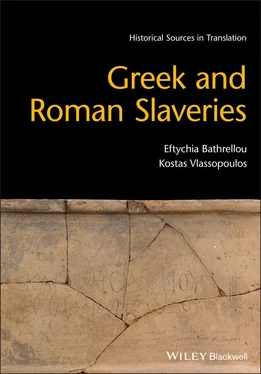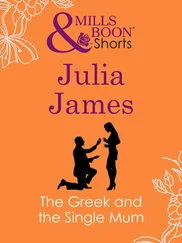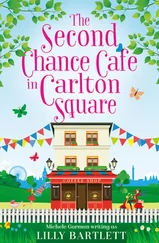“No, by Zeus!” the first man said, “for gymnastic trainers and other teachers cannot imprison their pupils, nor sell them nor throw them into the mill; masters, however, are allowed to do all these things.”
“Well, perhaps you are not aware of the fact that among many communities, and extremely well-ordered ones at that, fathers are allowed to do to their sons all these things you mentioned, including selling them, if they so wish, and even more terrible than these: that is, they are allowed to kill them, without trial or without even bringing any accusations at all against them. Yet these men are not their fathers’ slaves but their sons. And if I was as much of a slave as could be,” he said, “and had been one justly from the beginning, what prevents me being as much of a free man as anyone else from now on? Or what prevents you from the opposite fate? That is, if you had been born to manifestly free parents, to be now more of a slave than anyone else?”
“I can’t see,” the first man said, “how I, a free man, will become a slave, but it is not impossible that you have become free, if your master manumitted you. […] How, as you claim, can I become a slave?”
“Well, countless men, while free, sell themselves, and end up working as slaves by contract – sometimes not at all on reasonable terms, but on the harshest ones.”
Up to this point, those present paid attention to the arguments with the idea that they were put forward not so much in earnest as in jest. Afterward, however, they started to be more involved in the rivalry, and it seemed to them odd that it was not possible to name a criterion by which one could indisputably distinguish the slave from the free, but instead, it was easy to question everything and produce counter-arguments constantly. So, they set aside the particular case of that man and his slavery and started to examine who is a slave. And they tended toward the conclusion that the man who is validly possessed by someone else, like another item of his property or another one of his grazing animals, to the degree that he can be used in any way the owner wants, this man is correctly called and is the slave of his owner. Once more, the man who had been bringing counter-arguments in relation to slavery raised the question: what on earth determined the validity of possession? For many long-time owners had been shown to possess houses, or fields, or horses, or oxen unjustly, including even some who had inherited these things from their fathers. Similarly, it was possible to possess a man unjustly.
“For owners acquire slaves, similarly to all the rest of their property by taking them from others, or as gifts, or by purchase, or by inheritance, or by having them born in their own house – those called ‘home-born’ slaves. Another way of possession, which I think is the most ancient of all, is when men are taken as war captives or through plunder and are thus enslaved. It stands to reason that those who were first enslaved were not initially born slaves but were defeated in war or captured by robbers and were thus forced to be slaves to their captors. So, the most ancient way, which all the rest depend on, is extremely weak and has no strong value. For whenever these men manage to flee again, nothing prevents them from being free, as they were slaves unjustly; consequently, they were not slaves before that either. In fact, there are cases in that not only did they themselves flee from slavery but also enslaved their masters. In this case, too, a shell flips, as they say, and everything becomes the opposite of what it was before.”
One of the bystanders said that the captured persons themselves could not perhaps be called slaves, but those born to them, and those of the following generation and the one after that, could fittingly be called slaves.
“But how? For if being captured makes one a slave, then the name of slave would be more fitting to those captured than to their children; if again it is having been born to slaves what makes one a slave, then clearly the children born to men who were free but got captured cannot be slaves. […] So, if even this way of possession, from which all the others derive, is not just, it is possible that no other such way is just, and no one can be characterized as really and truly a slave. But perhaps to start with, we should not characterize as a slave one for whose body money has been paid or one born to parents characterized as slaves, as is widely thought, but rather one whose behavior is not that of a free man but befitting a slave. For we can agree that many called slaves have the comportment of free men, while many free men behave in ways much befitting a slave.” […]
At what circumstances does the first man accuse his interlocutor of being a slave? What does this show about the ways slavery is understood?
How does the man who accuses the other of being a slave understand and define slavery throughout the oration?
What are the problems of such definitions, according to his interlocutor? What do you think?
What is the definition of slavery agreed by the bystanders? What are its problems?
What is the last conception of slavery presented in the oration? No real objections are raised to that in the oration, but what is your opinion?
1 6 Andreau and Descat 2011.
2 7 Patterson 1982.
3 8 Lewis 2018.
4 9 Harper 2011.
5 10 Vlassopoulos 2021a.
6 11 Unless otherwise specified, we have translated what is considered the standard edition of the Greek and Latin literary texts.
7 12 See 1.11.
8 13 A people on the south coast of the Black Sea; cf. 3.29.
9 14 Sikyon and Argos are cities in the northern Peloponnese.
10 15 The legendary founder of Spartan social and political order.
11 16 In 369 BCE the Thebans invaded Laconia and Messenia, ultimately liberating the Messenian helots.
12 17 Greek text: Marr and Rhodes 2008.
13 18 In the original Greek, these officials are specified as holding the office of hypomnêmatographos, literally “recorder of deeds”.
14 19 According to this law, women with a certain number of children were allowed to act without a guardian. See also 10.17.
15 20 Greek text: Cunningham 2002.
16 21 The end of this sentence has not survived in its entirety.
17 22 CMG V 10,2,4.
18 23 A poisonous plant.
19 24 CMG V 4,1,2.
20 25 Greek text: von Arnim 1893–96.
2 Studying Slavery The Variety of Evidence and Its Interpretative Challenges
This chapter focuses on the methodological and evidentiary problems that scholars face when they use the various forms of evidence for ancient slavery. One major problem is that of identifying slaves in our sources. In many cases, there is no explicit labeling, and it is necessary to debate the criteria we use to identify slaves or former slaves (2.1–4). In other cases, the evidence is ambiguous and can be interpreted in various ways (2.4–5, 2.9–10); occasionally, we also get explicit identification of individuals as if they were still slaves, although there are reasons to doubt such labels (2.7). Sources can also use concurrently different terms for slaves, thus creating significant problems of interpretation (2.6).
The study of the material and visual culture of slavery has become a burgeoning field in recent years. But identifying slaves in the material and visual record presents problems of its own. What criteria should we use to make such identifications? What role does the depiction of slaves play in ancient objects (2.10, 2.12)? Sometimes epigraphic evidence makes it easy to identify ancient objects as made by or for slaves; consequently, such objects are extremely helpful for understanding the identities, values, and life histories of ancient slaves or former slaves (2.11). In other cases, epigraphic evidence is ambiguous, and the visual evidence becomes crucial for making identifications (2.13). But the most difficult question concerns the identification of slaves in the material record: can we locate slaves in ancient buildings on the basis of space use (2.14–5)?
Читать дальше












